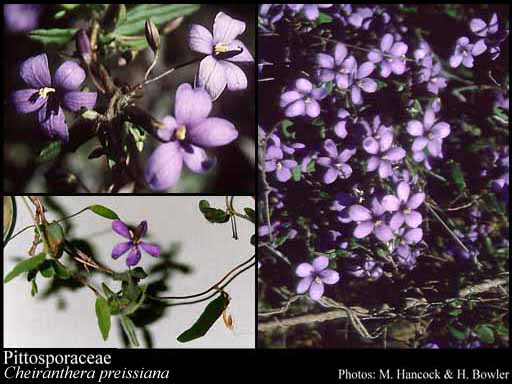- Reference
- Voy.Terra Austral. 2:542 (1814)
- Name Status
- Current

Scientific Description
Common name. Pittosporum Family.
Habit and leaf form. Trees, shrubs, and lianas; evergreen; with coloured juice, or non-laticiferous and without coloured juice; bearing essential oils, or without essential oils; resinous, or not resinous. Self supporting, or climbing; sometimes stem twiners, or scrambling (sometimes spiny). Sollya twining anticlockwise. Mesophytic, or xerophytic. Leaves alternate (usually), or whorled (sometimes, almost, towards the branch tips); usually spiral; ‘herbaceous’ (commonly soft), or leathery; petiolate; non-sheathing; gland-dotted, or not gland-dotted; aromatic, or without marked odour; simple. Leaf blades entire; pinnately veined; cross-venulate. Leaves without stipules. Leaf blade margins entire (usually, or undulate), or serrate. Leaves without a persistent basal meristem. Leaf anatomy. Hydathodes absent (even from crenate blades). Stem anatomy. Nodes unilacunar (occasionally), or tri-lacunar (usually). Secondary thickening developing from a conventional cambial ring.
Reproductive type, pollination. Fertile flowers hermaphrodite, or hermaphrodite, functionally male, and functionally female (rarely). Unisexual flowers present (rarely), or absent. Plants hermaphrodite (usually), or polygamomonoecious (rarely).
Inflorescence and flower features. Flowers solitary, or aggregated in ‘inflorescences’; in cymes, or in corymbs. The terminal inflorescence unit cymose, or racemose. Inflorescences terminal, or axillary; corymbs or thyrses. Flowers bracteolate (with two bracteoles); medium-sized, or large (often showy); regular; 5 merous; cyclic; tetracyclic. Free hypanthium absent. Perianth with distinct calyx and corolla; 10; 2 -whorled; isomerous. Calyx 5; 1 -whorled; polysepalous, or gamosepalous (sometimes basally connate); imbricate; regular; not persistent; with the median member posterior. Corolla 5; 1 -whorled; polypetalous, or gamopetalous (usually, with a more or less distinct tube); imbricate; regular. Petals sessile, or clawed (the claws more or less connivent). Fertile stamens present (usually), or absent (female flowers). Androecium 5. Androecial members free of the perianth; sometimes weakly, basally coherent, or free of one another; 1 -whorled. Androecium exclusively of fertile stamens. Stamens 5; isomerous with the perianth; oppositisepalous; laminar, or filantherous. Anthers dorsifixed, or dorsifixed to basifixed (being almost basifixed in Citriobatus); non-versatile; dehiscing via pores, or dehiscing via short slits, or dehiscing via longitudinal slits; introrse. Fertile gynoecium present (usually), or absent (male flowers). Gynoecium 2(–5) carpelled. The pistil 1 celled (usually), or 2(–5) celled (rarely). Carpels reduced in number relative to the perianth to isomerous with the perianth. Gynoecium syncarpous; synstylovarious, or eu-syncarpous; superior. Ovary unilocular, or plurilocular; 1 locular (usually), or 2(–5) locular (rarely, completely or incompletely). Gynoecium when bilocular, transverse; stylate. Styles 1; attenuate from the ovary; apical. Stigmas wet type; non-papillate; Group IV type. Placentation usually parietal; rarely (i.e. when plurilocular), axile. Ovules in the single cavity when unilocular, 5–100 (? — to ‘many’); 4–30 per locule; horizontal, or ascending; arillate, or non-arillate; anatropous to campylotropous.
Fruit and seed features. Fruit fleshy, or non-fleshy; dehiscent, or indehiscent; a capsule, or a berry. Capsules loculicidal. Seeds endospermic. Endosperm oily. Seeds winged (rarely), or wingless. Embryo well differentiated (tiny). Cotyledons 2–5. Embryo achlorophyllous (2/2). Seedling. Germination phanerocotylar.
Geography, cytology, number of species. World distribution: Old World tropics and Australasia. X = 12. 200 species.
Economic uses, etc. Edible berries (‘appleberry’) from Billardiera longiflora.